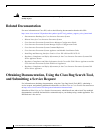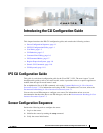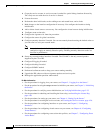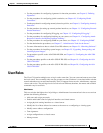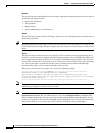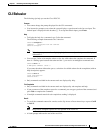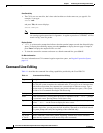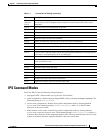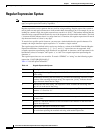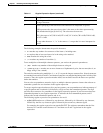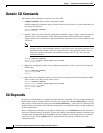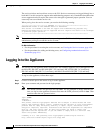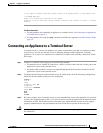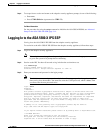
1-8
Cisco Intrusion Prevention System CLI Sensor Configuration Guide for IPS 7.1
OL-19892-01
Chapter 1 Introducing the CLI Configuration Guide
Regular Expression Syntax
Regular Expression Syntax
Note The syntax in this section applies only to regular expressions used as part of a CLI command. It does not
apply to regular expressions used by signatures.
Regular expressions are text patterns that are used for string matching. Regular expressions contain a
mix of plain text and special characters to indicate what kind of matching to do. For example, if you are
looking for a numeric digit, the regular expression to search for is “[0-9]”. The brackets indicate that the
character being compared should match any one of the characters enclosed within the bracket. The dash
(-) between 0 and 9 indicates that it is a range from 0 to 9. Therefore, this regular expression will match
any character from 0 to 9, that is, any digit.
To search for a specific special character, you must use a backslash before the special character. For
example, the single character regular expression “\*” matches a single asterisk.
The regular expressions defined in this section are similar to a subset of the POSIX Extended Regular
Expression definitions. In particular, “[..]”, “[==]”, and “[::]” expressions are not supported. Also,
escaped expressions representing single characters are supported. A character can be represented as its
hexadecimal value, for example, \x61 equals ‘a,’ so \x61 is an escaped expression representing the
character ‘a.’
The regular expressions are case sensitive. To match “STRING” or “string” use the following regular
expression: “[Ss][Tt][Rr][Ii][Nn][Gg].”
Table 1-2 lists the special characters.
Table 1-2 Regular Expression Syntax
Character Description
^ Beginning of the string. The expression “^A” will match an “A” only at the beginning
of the string.
^ Immediately following the left-bracket ([). Excludes the remaining characters within
brackets from matching the target string. The expression “[^0-9]” indicates that the
target character should not be a digit.
$ Matches the end of the string. The expression “abc$” matches the sub-string “abc”
only if it is at the end of the string.
| Allows the expression on either side to match the target string. The expression “a|b”
matches “a” as well as “b.”
. Matches any character.
* Indicates that the character to the left of the asterisk in the expression should match 0
or more times.
+ Similar to * but there should be at least one match of the character to the left of the +
sign in the expression.
? Matches the character to its left 0 or 1 times.
() Affects the order of pattern evaluation and also serves as a tagged expression that can
be used when replacing the matched sub-string with another expression.



